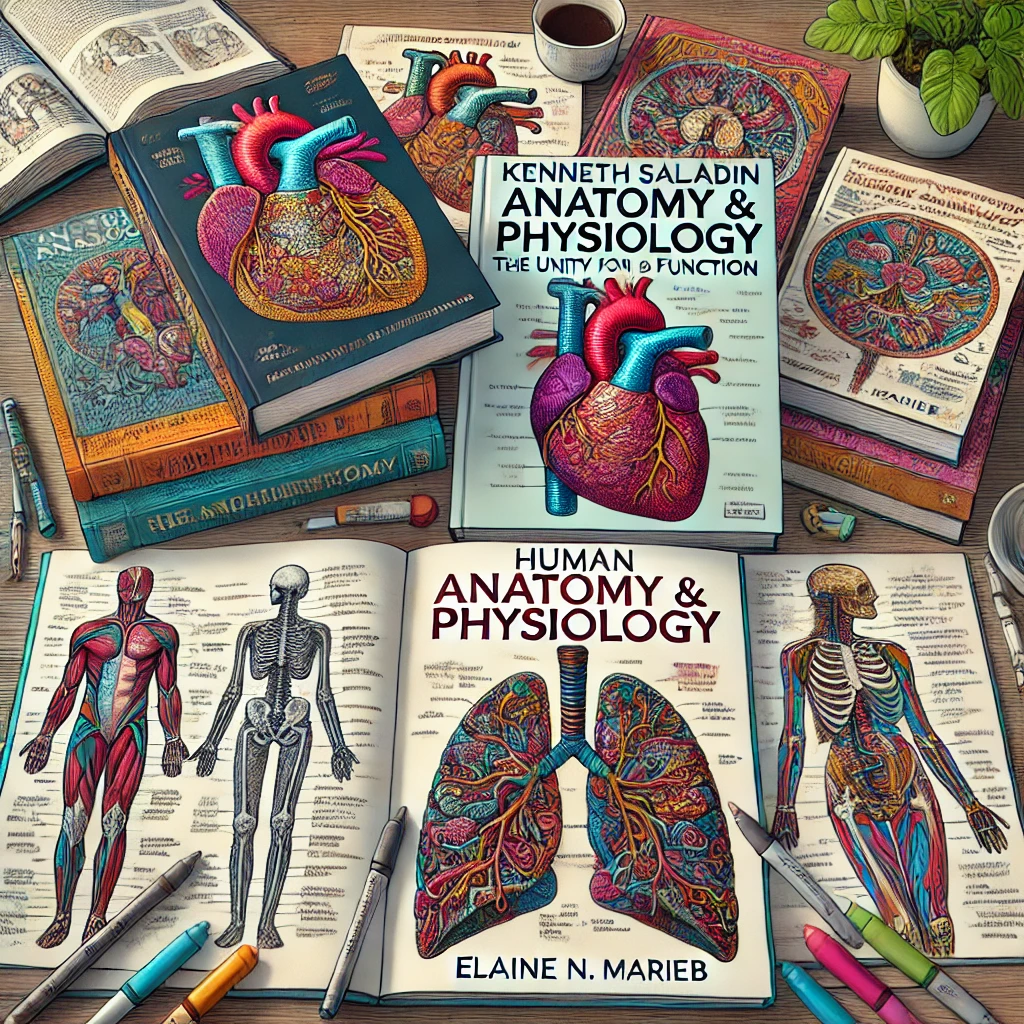Studying anatomy and physiology can be like exploring a whole new world—the world inside your own body! It’s all about understanding how our bodies are put together and how they work. But to really dive into this subject, you need the right tools. And by tools, I mean textbooks. So, if you’re ready to get started on your journey through the human body, here are some of the top textbooks that will help you along the way.
Kenneth Saladin Anatomy & Physiology: The Unity of Form and Function 8th Edition
Why it’s Great: This book is a favorite among students because it’s like having a friendly guide taking you on a tour through your body. Kenneth Saladin knows how to explain things in a way that makes sense, even if you’re just starting out. The “Unity of Form and Function” part of the title means that this book helps you see how the structure of your body (anatomy) is closely related to how it works (physiology). For example, it explains why the heart’s shape is perfect for its job of pumping blood.
What’s Inside: The 8th edition of this book has been updated with the latest information, so you’re getting the most accurate facts. It’s packed with colorful pictures, diagrams, and real-life examples that make learning fun. Plus, there are review questions at the end of each chapter to help you check what you’ve learned.
Who Should Use It: If you’re someone who likes to see the big picture and understand how everything in the body is connected, this book is for you. It’s also great for high school students, college students, or anyone who wants a solid foundation in anatomy and physiology.
2. Human Anatomy & Physiology” by Elaine N. Marieb and Katja Hoehn
Why it’s Great: This textbook is like the Swiss Army knife of anatomy and physiology books—it’s got a little bit of everything. Marieb and Hoehn have created a book that’s super easy to read, even if science isn’t your favorite subject. They break down complex topics into simple ideas, so you can understand things without getting lost in technical terms.
What’s Inside: The book is filled with clear explanations, engaging illustrations, and even real-world applications that show you why this stuff matters. There are also interactive features, like online quizzes and videos, to help you learn in different ways. And if you’re a visual learner, the detailed diagrams will be your best friend.
Who Should Use It: This book is perfect for students who are new to anatomy and physiology. If you’re in high school or just starting college, this book will guide you through the basics in a way that’s not overwhelming.
Read More: The future of assignment writing services in higher education
3. “Principles of Anatomy and Physiology” by Gerard J. Tortora and Bryan H. Derrickson
Why it’s Great: Tortora and Derrickson’s book is like a trusted coach who wants you to succeed. It’s been a popular choice for years because it provides a thorough introduction to both anatomy and physiology. The book’s strength is in how it connects the dots between different systems in the body, helping you see how everything works together.
What’s Inside: This textbook is organized in a way that makes it easy to follow along. It starts with the basics, like the structure of cells and tissues, and gradually builds up to more complex topics like the nervous and endocrine systems. Each chapter is filled with illustrations, clinical cases, and study tips to help you grasp the material.
Who Should Use It: If you’re a serious student who wants to get a deep understanding of anatomy and physiology, this book is a great choice. It’s ideal for high school students in advanced classes or college students who need a reliable textbook for their courses.
4. “Essential Anatomy & Physiology” by Valerie C. Scanlon and Tina Sanders
Why it’s Great: This book is all about the essentials—just what you need to know, without any extra fluff. Scanlon and Sanders have created a textbook that’s concise but still comprehensive, making it a perfect choice for students who want to focus on the key concepts.
What’s Inside: The book is structured in a way that makes learning efficient. Each chapter starts with an overview of what you’ll learn, followed by clear explanations and helpful illustrations. There are also quick review sections at the end of each chapter, so you can make sure you’re on track.
Who Should Use It: If you’re a student who prefers a straightforward approach to learning, this book is for you. It’s great for high school students, nursing students, or anyone who needs a solid foundation in anatomy and physiology without getting bogged down in too much detail.
5. “The Anatomy Coloring Book” by Wynn Kapit and Lawrence M. Elson
Why it’s Great: Okay, this one’s a little different—it’s a coloring book! But don’t let that fool you; it’s a powerful learning tool. Wynn Kapit and Lawrence Elson have created a book that helps you learn by coloring in the different parts of the body. It’s a fun and interactive way to study, and it can really help the information stick in your mind.
What’s Inside: The book is filled with detailed drawings of various body parts, and each section comes with explanations and descriptions. As you color in the pictures, you’ll learn about the different structures and how they fit together. It’s a hands-on way to study that’s perfect for visual learners.
Who Should Use It: If you’re someone who learns best by doing, or if you just like to have a little fun while studying, this book is for you. It’s great for students of all ages, and it can be a helpful supplement to your regular textbook.
6. “Atlas of Human Anatomy” by Frank H. Netter, MD
Why it’s Great: Sometimes, you just need to see things in detail to really understand them. That’s where Frank Netter’s atlas comes in. It’s filled with detailed, lifelike illustrations that show you exactly what different parts of the body look like. It’s like having a road map for your body!
What’s Inside: The atlas covers all the major systems in the body, with illustrations that are both accurate and beautiful. Each page is packed with information, and the labels and descriptions make it easy to learn as you go. This book doesn’t just show you what things look like—it helps you understand why they’re important.
Who Should Use It: This atlas is a great resource for students who are serious about anatomy. It’s perfect for high school students, college students, or even medical students who need a visual reference to complement their studies.
7. “Anatomy & Physiology For Dummies” by Maggie Norris and Donna Rae Siegfried
Why it’s Great: Don’t let the title fool you—this book is no joke when it comes to helping you understand anatomy and physiology. Norris and Siegfried have created a guide that’s easy to read and packed with helpful tips. It’s like having a tutor by your side, explaining things in simple terms.
What’s Inside: The book covers all the basics, from the skeletal system to the circulatory system, with explanations that are clear and to the point. There are also plenty of diagrams, tips, and tricks to help you remember what you’ve learned. Plus, the book’s light-hearted tone makes it a fun read.
Who Should Use It: If you’re just starting out and need a little extra help, this book is perfect for you. It’s great for high school students, college students, or anyone who wants to get a solid grasp of anatomy and physiology without getting overwhelmed.
8. “Gray’s Anatomy for Students” by Richard L. Drake, A. Wayne Vogl, and Adam W. M. Mitchell
Why it’s Great: Gray’s Anatomy is one of the most famous names in the world of anatomy, and this version is specifically designed for students. Drake, Vogl, and Mitchell have taken the classic text and made it more accessible for modern learners, with clear explanations and up-to-date information.
What’s Inside: The book is organized by body systems, making it easy to follow along. Each section is packed with illustrations, clinical insights, and summaries that help you understand the material. It’s a thorough guide that covers everything you need to know, but it’s written in a way that’s easy to digest.
Who Should Use It: This textbook is perfect for students who are serious about studying anatomy. It’s great for advanced high school students, college students, or anyone who wants to get a deep understanding of the subject.
9. “Hole’s Essentials of Human Anatomy & Physiology” by David Shier, Jackie Butler, and Ricki Lewis
Why it’s Great: Hole’s Essentials is known for being straightforward and easy to understand. Shier, Butler, and Lewis have created a textbook that’s perfect for beginners, with a focus on the key concepts you need to know.
What’s Inside: The book covers all the basics, with clear explanations and helpful diagrams. Each chapter starts with an overview of what you’ll learn, and there are plenty of review questions to help you test your knowledge. It’s a concise, no-nonsense guide to anatomy and physiology.
Who Should Use It: If you’re just getting started with anatomy and physiology, this book is a great choice. It’s ideal for high school students, nursing students, or anyone who needs a solid introduction to the subject.
10. “Martini’s Fundamentals of Anatomy & Physiology” by Frederic H. Martini, Judi L. Nath, and Edwin F. Bartholomew
Why it’s Great: Martini’s textbook is known for its clarity and depth. It’s a comprehensive guide that covers everything you need to know about anatomy and physiology, with plenty of illustrations and real-world examples to help you understand the material.
What’s Inside: The book is organized by body systems, with detailed explanations and plenty of diagrams. There are also case studies and clinical notes that show you how the material applies to real-life situations. It’s a thorough and engaging guide that’s perfect for serious students.
Who Should Use It: This textbook is ideal for students who want to get a deep understanding of anatomy and physiology. It’s great for high school students in advanced classes, college students, or anyone who wants a comprehensive guide to the subject.
Final Thoughts
Studying anatomy and physiology can be a challenging but rewarding journey. With the right textbook, you can explore the wonders of the human body and understand how everything fits together. Whether you’re just starting out or looking to deepen your knowledge, these textbooks offer the tools you need to succeed.
Remember, the key to mastering anatomy and physiology is to stay curious and keep asking questions. The more you explore, the more you’ll discover about the amazing world inside you. So grab your textbook, dive in, and start learning!


